Lure and Bait Rigging
How your tackle is rigged depends on the fish you’re after. This could be on the surface, bottom, or somewhere in between. Though it’s not an exact science, selecting the proper weight, hook, float, line, bait, or lure are all important factors. Also learning how to rig your tackle for certain fish, will help you to apply similar techniques in different situations.
Proper rigging is as important as the lures or baits used to catch fish. It’s also important to use the right tackle. There are endless possibilities on rigging lures and baits with some shown below. Look at the examples below to help pick the best ones. Surface feeders won’t take baits that are fished on bottom.
Rigging Plastic Baits
Plastic baits encompass a large number of lures that come in unlimited shapes and sizes. The most popular baits are plastic worms, lizards, salt craws, and grubs, and come in a variety of shapes, sizes, and colors. Plastic baits can be rigged in many ways depending on how you want to present the bait or lure. Shown here are two popular methods for rigging plastic baits.
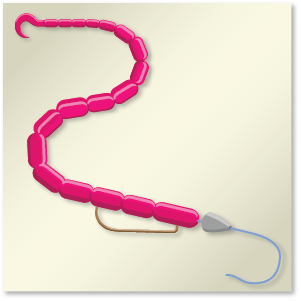 Texas Rig
Texas Rig
The Texas rig, shown here is a simple but effective rigging method when using plastic baits. The Texas rig is used with a bullet weight or slip sinker that is threaded on the line directly to the hook and plastic bait. This is an excellent rig for fishing the plastic bait directly on the bottom or swimming through weeds and tree limbs.
With the Texas rig, because the line slips easily through the weight, the fish is less likely to feel any resistance. It may be difficult at times to feel the fish take the bait so watch for line movement to the left or right or become slack.
To keep the bullet weight in contact with the bait at all times, a toothpick can be used to secure the weight to the line. This prevents the bait and weight from hanging on either side of tree limbs, rocks, or weeds.
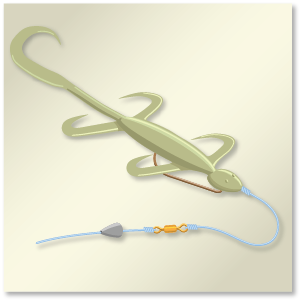 Carolina Rig
Carolina Rig
The Carolina rig, shown here is an effective rigging method when floating plastic baits off the bottom. With the Carolina rig, a barrel swivel is tied to the line 12 to 24 inches above the bait. The other end of the line is tied from the swivel to the main line. The weight used with the Carolina rig holds the line close to the bottom while allowing the bait or lure to float. When using a barrel swivel, a bullet weight can be used to hold the rig on the bottom and when a fish takes the plastic bait, the line slips through the weight with no resistance.
It takes practice to feel a strike using the Carolina rig as the fish may have the bait before you feel it. It’s also possible that the could take and spit out the bait without you knowing it.
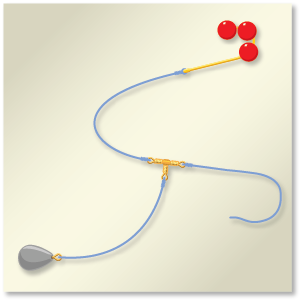 Drift Rig
Drift Rig
The drift rig is used to fish close to the bottom while keeping the bait suspended. This rigging method is good when fishing areas where the bait or lure needs to be suspended above rocks or weeds. The rig can be used while still fishing, reeling the line in slowly or letting the sinker bounce along the bottom as the boat moves. The drift rig works well when drift fishing for trout in Missouri.
As shown in the example, the hook is tied to a section of fishing line that is tied to one eye of the swivel. Another section of line is used to tie the bell sinker to another eye and the line going the reel is tied to the third eye. Using the three-way swivel allows the lines from the hook to reel to follow a straight line. The bell sinker then hangs down. The length of the lines to the hook and the sinker are determined by preference or fishing conditions.
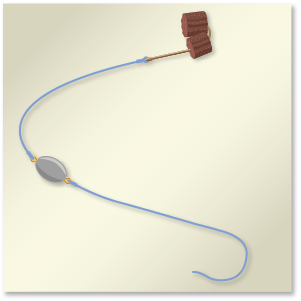 Barrel Weight Rig
Barrel Weight Rig
The barrel weight rig, shown here is similar to the Carolina rig and is an effective rigging method when floating baits off the bottom. With the barrel weight rig, a barrel weight is tied to the line at a desired length above the hook and bait. The other end of the line is tied from the weight to the main line. The weight used with the barrel weight rig holds the line close to the bottom while allowing the bait to float.
The barrel weight rig is a great option when fishing for catfish and other bottom feeding fish but can also be used when fishing with plastic baits.
Just add your favorite bait and cast out then hold on for the action.
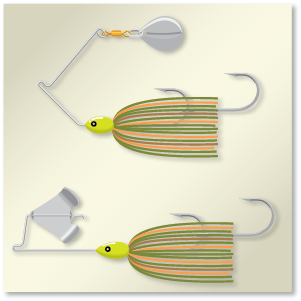 Trailer Hook
Trailer Hook
When fishing with spinner baits or buzz baits, fish will at times strike the skirt just short of the hook. The solution is to attach a trailer hook onto the main hook which will increase the chances of hooking the fish.
The trailer hook slides over the main hook and is held in place using a small rubber washer. This allows the bait to work as expected without affecting performance. What can be frustrating is storing the baits with the trailer hooks attached. Since the hooks can hang freely, they will get tangled on other baits in the box.
If you find yourself missing strikes when using spinner baits or buzz baits, add a trailer hook.
Rigging Live Baits
Plastic baits encompass a large number of lures that come in unlimited shapes and sizes. The most popular baits are plastic worms, lizards, salt craws, and grubs, and come in a variety of shapes, sizes, and colors. Plastic baits can be rigged in many ways depending on how you want to present the bait or lure. Shown here are two popular methods for rigging plastic baits.
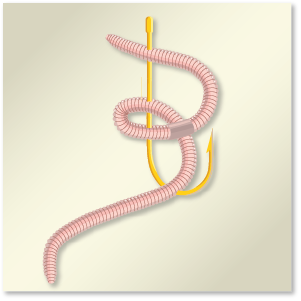 Worms
Worms
Worms or night crawlers are probably the number one live bait used. For most fishermen, their first memories of fishing included worms. Even though fish probably never see worms in their everyday lives, they do love to eat them. Worms are available almost everywhere, anytime of the year. This includes bait shops and your own backyard.
If you want to find worms, look under large flat rocks, in the garden, or in the driveway after a good rain. If you want to attract worms, lay a piece of flat concrete over some bare soil that stays cool and moist most of the time. When you’re ready to go fishing, lift up the concrete and take the worms you need. Worms can be fished suspended from a bobber or on the bottom, it depends on the fish your after. As shown, worms should be threaded on the hook, not in just one spot leaving the rest to dangle for the fish to nibble on. If fishing for small fish such as bluegill, try using just pieces of the worm on the hook.
It’s important to keep your worms alive as the day goes on. To do this, keep them in the container they came in and keep them cool and moist. Don’t leave the container in the hot sun, this will only kill the worms. To save the left over worms for another trip, place the container in the refrigerator, they’ll can stay alive for weeks that way.
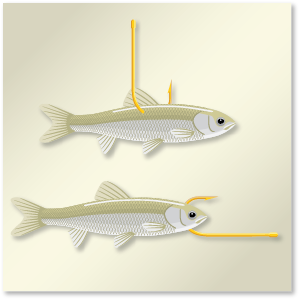 Minnows
Minnows
A very popular live bait, minnows or shiners probably rank second only to live worms. Minnows can be used to catch almost any type of fish and can be used with numerous rigs. Though game and pan fish love minnows, fishing a minnow in its natural position will give the best results. Dead minnows will catch fish, but live minnows will always work better.
How a minnow is hooked depends on the fish your after and the rig used. As illustrated, minnows can be hooked in one of two ways. If using a float, hook the minnow in the back just below the dorsal fin. If fishing on the bottom, hook the minnow through the lips. Both methods will put the minnow in a more natural position.
A very active minnow can move a float around and make it bob up and down. This is fine as long as the minnow can’t pull the float under. Watch the float when using a minnow, erratic movements will many times indicate a fish nearby. Also, if the float goes under, set the hook right away. Don’t let the fish play with the minnow, since the it’s live bait, the fish will try to swallow the minnow. This often results in a deep hook set that will kill the fish, even if you don’t plan to keep it.
Because you may be fishing all day long, it’s important to take special care of your minnows. A few simple steps will help to keep the minnows alive for a longer period of time. First, keep the minnow bucket out of the sun, the warming water will just kill the minnows. A battery powered aerator can be placed in the bucket to replenish the oxygen, or replace the water with fresh lake water every couple of hours.
If you don’t normally use live bait, give minnows a try, especially when teaching kids to fish. The action can be non-stop.
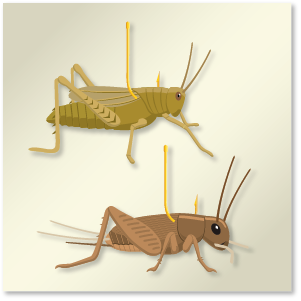 Insects
Insects
Though grasshoppers and crickets are good baits, of the two, crickets are used more often. Crickets are easier to raise and care for, and are available at most bait shops anytime of the year. If you can’t get any crickets, grasshoppers can usually be caught in nearby fields.
Grasshoppers and crickets work well when fishing for panfish. Hook them just under the surface of the thorax. Grasshoppers and crickets can be fished using a bobber or on the surface if using a floating line.
To keep the grasshoppers and crickets alive, place them in a screened container. One can be purchased at almost any tackle store. Place a piece of apple or potato in the container to provide a source of moisture for the grasshoppers or crickets. Also, try to keep the bait out of the sun and in a cool place.
 Eggs
Eggs
Salmon or power eggs are very popular when fishing for Trout. The eggs can be fished in any type of water but seem to work best in moving water or trolled behind a boat. The eggs can be used one at a time or clustered on a treble hook. If fished in moving water or trolled, a drift rig seems to work best, keeping the egg just off the bottom and above vegetation and debris.
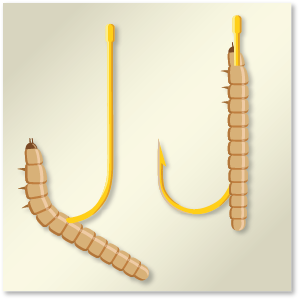 Mealworms
Mealworms
The larva form of the beetle, mealworms are a great bait for panfish and trout. With an exoskeleton, the mealworms is a hardy bait and unlike worms, they float. This will get the bait off the bottom. Most bait and pet shops will carry live mealworms which are best for fishing bait, but dried worms will work also, which can be found in pet stores and farm stores.
Hook mealworms lengthwise to hide the hook. If you need a snack, mealworms can be eaten by people.
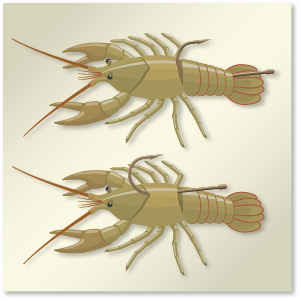 Crayfish
Crayfish
Minnows and worms are popular baits, but don’t overlook crayfish. Also known as crawdads, crayfish are a popular live bait and also a major food for fish like largemouth, smallmouth and rock bass. A testament to their popularity is the jig-n-pig, a lure that mimics the crayfish.
Crayfish can be purchased at bait stores or if you’re adventurous, they can be found and caught in streams and creeks. Look around weeds and under rocks. Keep crayfish in cool water and provide some lunchmeat to keep them busy and from fighting.
Hook crayfish from the tail to the back of the abdomen or through the abdomen. Both rigging methods allow the crayfish to move freely or reeled back in their natural backwards movement. A carolina rig works well when fishing with crayfish. Also, use the size crayfish for the size fish you’re after. An alternative to live crayfish is the jig-n-pig and plastic baits.
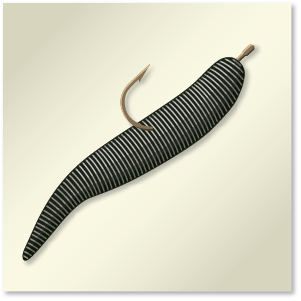 Leeches
Leeches
Similar to a live worm, leaches are sometimes used for catching fish when they’re holding in deep water. Hook the leach just once, then cast. Leaches are hardier than worms, and will last a bit longer.
